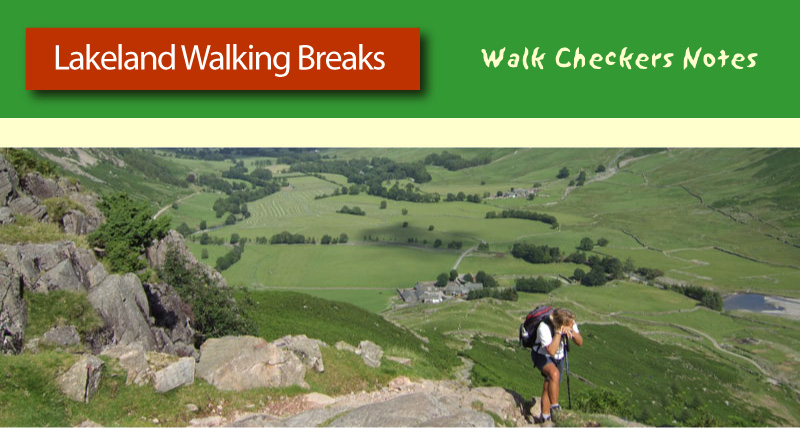Lingmoor, in Langdale, draws me back time after time. So when looking for a fell walk to fill a few hours on a cold and showery Saturday in February with two good friends, it was an obvious choice. Overnight snow on the fell tops added to the splendour of the scenery, whilst the heavy shower cloud hung menacingly over the central fells, giving them a mean and moody look.
We started in Elterwater, at the National Trust car park, and headed towards the quarries via the river. This first half mile is very pleasant, and helps to get the muscles nicely warm before the main climb starts. From across the quarry the Langdale Pikes were bathed in sunshine, capped with a light dusting of snow, and surrounded by menacing looking cloud, all adding to the atmosphere of the day. Despite it being Saturday, the quarries were not silent, winning the slate is clearly not a Monday to Friday 9 - 5 job.
From the quarries it is a 1/2 a mile walk along first a bridleway, and then an old quarry track, to reach the old quarry spoil heap overlooking the village of Chapel Stile. I've been here many times before, of course, but what was different about today was the backdrop. Despite heavy cloud all around, there was a bright clearing of blue sky and the sun was glinting on the snow covered mountains of the Fairfield Horseshoe. The Blue Sky did not last.
From the spoil heap, we then headed up the quarry track as it skirts the fell, before turning sharp left to follow the path up the fell to a green gate with a built in stile.
From the gate, we turned right to follow the line of the wall. This wall runs close to the top of the fell, and the path follows it for most of that distance. Behind us, as we climb, the views of Windermere are superb, even on a day such as this.
Half way to the top we are hit by a sharp rain shower. Hail, rain, and strong winds blow in from over Wetherlam. It gives us an exhilarating ten minutes, and the added bonus of this rainbow. It is not a common view on the fells.
With the rain quickly clearing through, we are treated to superb views across the fell towards Crinkle Crags, Pike O Bliscoe and Bowfell, all of which were shrouded in cloud.
Meanwhile, looking north over Great Langdale we can clearly see Pavey Ark and the flat looking top of Harrison Stickle. The occasional gap in the cloud throwing sunlight on one area of fell, whilst others remain in dark shade.
The summit of Lingmoor is Brown Howe, so called because it is clad in a mixture of bracken and heather which for much of the year gives it a brown appearance. It also has this stunning view of the Langdale Pikes
Still at the summit, this superb view down Great Langdale to Chapel Stile can be seen. Seat Sandal, Nethermost Pike and Dollywagon Pike are in the distance, while the summit of Helvellyn is covered in cloud.
Our route back is via the flank of the fell, passing by the old quarries that dot this region. From the top we drop down the steep slope, following the line of an old wall, that has been supplemented at the top by a wire fence, to this stile over the wall. From here there is a fine view up Mickleden, with the Band visible to the left, and the summit of Bowfell shrouded in cloud.
We could cross the stile to drop down towards Blea Tarn, but that is for another day. Instead, we turn left, along a barely visible yet boggy path, towards an abandoned quarry, a great lunch stop.
From the quarry we continue along the flank of the fell, passing by other quarry workings. There are several small workings on the side of the fell, with abandoned buildings and spoil heaps the only sign of their existence. In the background, the summit of Wetherlam enjoys a brief interlude from the cloud, before being shrouded in mist again.
Another abandoned quarry working on the fell side. The small quarrymans hut has what appears to be a chimney at one end, with a gap for a small fire beneath. I cannot have been the best work in bad weather.
As we continue along the fell side, dropping gradually as we go, the views to the south over Little Langdale are superb, with Little Langdale Tarn prominent in the valley below.
The path drops down the fell side, towards a wide track that will lead us back to Elterwater. It is quite steep in parts, and rocky and wet underfoot. A certain amount of erosion control work has been undertaken otherwise it would be considerably worse.
Looking across the valley bottom, towards Wetherlam, with Little Langdale Tarn looking dark and foreboding. The water in this tarn always has a grey look to it, even on sunny days. I'm lead to believe that this is due to the local geology. A dull day like today does not help though.
A friendly Herdwick greets us at the bottom. Apart from a couple of sheep on the road to the quarries at the start of the walk, this was the only farm animal that we encountered all day. However, we did see numerous birds, including Buzzards and a very cheeky robin. Trouble is, I was too slow to get a picture of them.








































